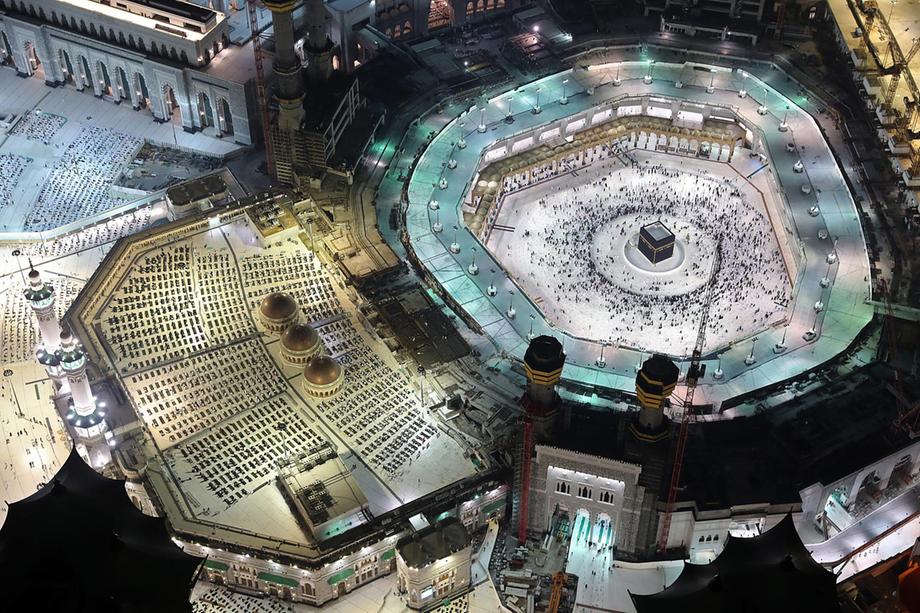Muslims mark Eid Al Fitr every year at the end of Ramadan. It is considered the “festival of breaking the fast” and coincides with the start of Shawwal, the month following Ramadan.
In 2020, Eid prayers were fully celebrated at home while some countries chose to mark the event by holding virtual Takbirs and parking lot prayers, to preserve the feel of Eid – dressing up and going to prayers with the family.After the introduction of vaccines around the world, countries started to ease restrictions and lockdown measures. Here are 10 historical mosques ahead of Eid celebrations around the world:
Sheikh Zayed Mosque – Abu Dhabi
Sheikh Zayed mosque was just a dream as recently as the 1980s, but is now noted as one of the largest mosques in the world, able to accommodate 55,000 worshippers. Situated in Abu Dhabi, the capital of the UAE, it houses one of the largest hand-knotted carpets and 82 pure white marble cladding domes in the centre of the main prayer hall, with crescent-shaped gold finials.
Al Haram – Makkah
Masjid Al Haram, also known as the holy mosque or the Great Mosque of Makkah, surrounds the holiest shrine in Islam, the Kaaba. From the wall surrounding the Kaaba, built by one of the most influential and powerful caliphs, Umar bin Al Khattab, to rebuilding the mosque again in the 14th century and recent expansions in the 20th century, it took centuries to fully develop the mosque to what it is today. The mosque accommodates millions of worshippers and pilgrims every year.

Al Aqsa – Jerusalem
Al Aqsa mosque is in the Old City of Jerusalem, and is the third holiest site in Islam after Makkah and Madinah. The name Aqsa means “the farthest” referring to Prophet Mohammed’s night journey after Makkah. Muslim worshippers prayed towards the Aqsa mosque briefly before the Quranic revelation to face the Kaaba, the holiest shrine in Islam for prayers. It dates back to 705 CE which was completed by Ummayad Caliph Abd Al Malik and his son Al Walid.
Hassan II – Casablanca
Designed by French architect Michel Pinseau, construction of the historic mosque commenced in the 1980s and took more than seven years and 10,000 craftsmen to complete. The mosque is not only one of the largest in the world but also contains the best of technology, having been kitted out with a renewable solar energy system in 2016. King Hassan II commissioned the mosque to be one of the most influential and inspiring structures in Morocco, able to accommodate up to 25,000 worshippers.
Blue Mosque – Istanbul
Sultan Ahmet Mosque, which is widely known as the Blue Mosque because of its prominent hand painted blue tiles, is in Istanbul. It was built at the request of Sultan Ahmet I and is one of the most influential structures from the Ottoman dynasty. The interior of the mosque is lined with more than 20,000 handmade İznik style ceramic tiles.
Amr Ibn Al As – Cairo
Located at the centre of Egypt’s old capital, Al Fustat, the mosque is named after Amr Ibn Al As who was the commander of the Muslim conquest of Egypt. The original structure was the first mosque built in Egypt and Africa and its completion dates back to 641-642 AD, although it has been rebuilt since, in 1179 and in 1875.
Ubudiah – Kuala Kangsar
Located in Kuala Kangsar, Ubudiah mosque is considered one of the most stunning holy structures in Malaysia. Designed by the British architect Arthur Benison Huback at the request of Sultan Idris Mushidul Azam Shah, the mosque comprises four minarets and a golden dome, which was completed in the 1910s.
Mosque of Cordoba – Cordoba
One of the oldest structures still standing from the 8th century, when Muslims ruled Al Andalus, the mosque has held a place of importance in the Islamic community for three centuries. The original structure was built by the Umayyad rulerʿAbd Ar Raḥman I in 784-786 with further expansions and additions in the following years by his successors. It was converted into a Christian cathedral in the 13th century.
Badshahi – Lahore
For more than three centuries the spectacular mosque was the largest in the world. It can accommodate up to 100,000 worshippers on its grounds and was completed in the 1600s. Created by Mughal emperor Aurangzeb, it is in Lahore, capital of the Pakistani province of Punjab.
Arba’a Rukun – Mogadishu
One of the oldest mosques in the world, Arba’a Rukun was built circa 667 in the capital of Somalia, Mogadishu. To commemorate the late founder, Khusra ibn Mubarak Al Shir, the mosque’s mihrab – a semicircular wall that indicates the Qibla, contains an inscription dated from the same year.


Comment here